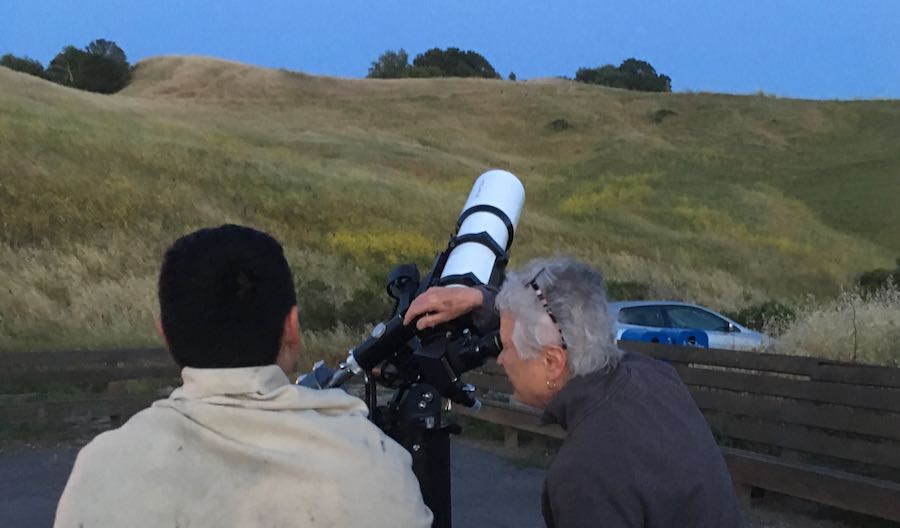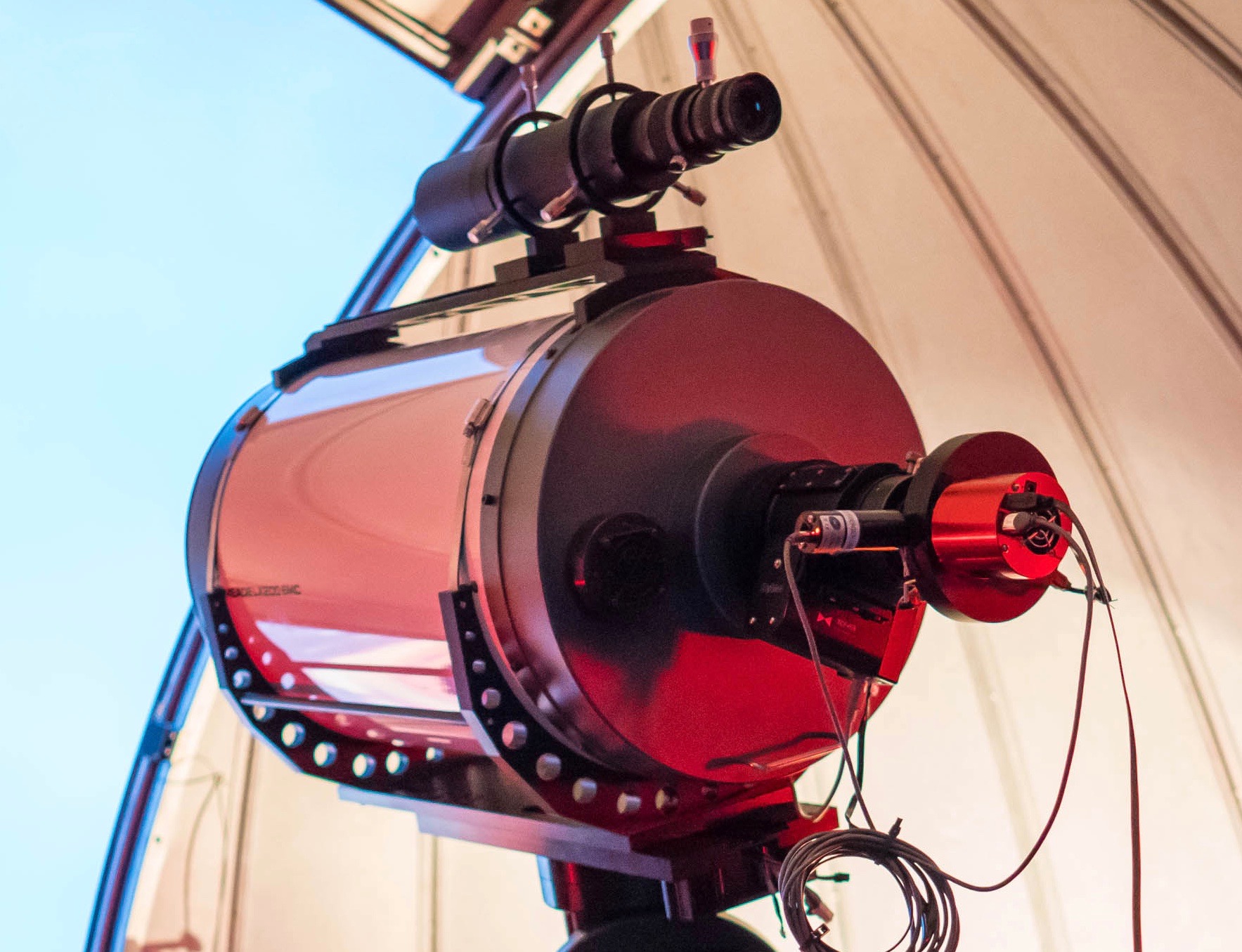Public Access
Due to the COVID pandemic, the observatory is currently closed to the public.
About
The Saint Mary's College Geissberger Observatory was created in 2003 under the observant eye of Prof. Ronald P. Olowin (1945-2017) with a generous gift from the Geissberger family in memory of Norma Geissberger. The proposal for the observatory has antecedents in correspondence of Br. Raphael Patton going at least as far back as 1983. Today the observatory is managed by Prof. Aaron Lee.
In spring of 2017, Profs. Hans de Moor and Brian Hill along with senior undergraduates Katherine Damiano and Justin Robinson took the first steps toward using the observatory for differential photometry of variable stars. Thanks to additional gifts in memory of Prof. Olowin, in 2018 an upgrade of virtually all of the astronomy equipment used for both teaching and research was undertaken.
Today, the observatory's 16-inch Meade is outfitted with equipment that can be used to record exoplanet transits. In summer of 2018, rising sophomore Ariana Hofelmann worked with Prof. Hill to upgrade the observatory and get it admitted to the Transiting Exoplanet Survey Satellite (TESS) Follow-Up Observing Program (TFOP).
In summer of 2019, rising junior Connor Martin worked with Prof. Hill to do additional major rehabilitation of the observatory equipment ranging from disassembling, cleaning, and collimating the 16-inch Meade to overhauling the observatory weather station.
The work of all four of these undergraduates prepared the observatory for contribution to TFOP. For a brief introduction to TESS and TFOP, see the video produced by Haley Nelson of the College's Communications Office: Summer Research: TESS Follow-Up Observing Program.
Forecasts
Forecasts and Current Conditions for the Saint Mary's College Geissberger Observatory.
Lectures
Location
The campus and observatory are located in Moraga, California which is east of Oakland and the first range of the East Bay’s coastal hills. These hills delay the arrival of the coastal fog that the Bay Area is well-known for. The dome is at 37° 50' 21.1" N and 122° 6' 8.7" W, and at an elevation of 277 meters.
On the satellite view below, the Geissberger Observatory Pad is at center-right and the Geissberger Observatory Dome is at upper-right. The satellite view is sufficiently detailed to show the constellation of six outdoor piers at the Observatory Pad. Clicking on the satellite view opens Google maps.
The pad is in a slightly protected position and has good horizon except to the east where targets must rise to about 25° to be visible. The dome is situated on the top of a small hill that is far enough from nearby hills so as to be limited principally by airmass in choice of targets rather than any obstruction. The weather station is halfway up the hillside rising from the pad to the dome. Relative to a major city, Moraga is about 16 miles east-northeast of San Francisco. During standard time, local time is UTC-8, and during daylight savings time, local time is UTC-7.
Telescopes
Thanks to the generous gifts mentioned above, the observatory now has four Stellarvue 102T and two Stellarvue 115T apochromatic refractors, and a Questar 7 Maksutov-Cassegrain. These are usually used at the observatory pad or taken to dark-sky sites. The telescope in the dome, a Meade 16-inch (0.4 meter) LX200 Schmidt-Cassegrain, will be discussed in the next section.

Photo Credit: Brian Hill
In the photo above, two members of the Saint Mary's community watch Jupiter rising in the southeast at the beginning of a May, 2018 astronomy night. The Stellarvue 102T they are using is riding on one of the six Losmandy GM8 mounts affixed to a pier in the observatory's constellation of six outdoor piers.
Research Equipment
As mentioned above, in the dome is the campus's largest telescope, a 0.4-meter Meade Schmidt-Cassegrain. From a research perspective, the telescope is well-suited to contributing to variable star astronomy, and among the most interesting and new variable star observations are those caused by exoplanet transits. The choices of equipment detailed in this section were made with exoplanet transit observations in mind.
To eliminate shortcomings in the 0.4-meter Meade's design, the telescope is fitted with an Optec TCF-S3i temperature-compensated focuser and an Optec NGC 316 0.75x reducer/flattener. The benefits of the Optec equipment are (1) the ability to lock the primary mirror's position and thereby eliminate mirror flop, and (2) the reducer/flattener corrects for the inherent aberrations (coma and field flatness) in the Schmidt-Cassegrain design. The reducer/flattener also increases the field of view, and allows larger format digital cameras to be used. Collimation of the Meade is maintained with a HOTECH Advanced CT Laser Collimator.
Because it is often important to observe exoplanet transits in specific optical bands, the Optec equipment is followed by a Starlight Xpress Mini USB filter wheel with an integrated holder for a Starlight Xpress Lodestar X2 autoguider. The filter wheel contains an Astrodon Exo-Planet Clear Blue-Blocker filter and Astrodon Gen 2 Sloan g', r', i' and z' filters manufactured by Optical Structures Inc.. The auto-guider allows the telescope to lock on to a specific star in a starfield and essentially eliminate pointing errors by keeping this star in the same position in the optical field.
At the end of the imaging train is a ZWO ASI 1600 MM-Cooled CMOS camera. This camera has a 21.9mm diagonal. With the Optec reducer/flattener it would in principle be possible to capture quality images with a camera format as large as 35mm. Calibration of the camera is performed using a Gerd-Neumann D420 Aurora flat-field panel.
The plate scale with the 0.75x reducer is 4064mm * 0.75 * 2 * pi / 360 / 3600 = 14.78 microns / arcsecond. The camera's pixel pitch is 3.8 microns. This would result in a plate scale of 0.257 arcseconds per pixel which is much finer than is warranted by the several arcsecond seeing at the site. Therefore we typically use 4x4 binning resulting in 1.029 arcseconds / binned pixel. An advantage of oversampling and then binning is that noise caused by changing positions of starlight over the pixel boundaries is substantially reduced by the averaging.
The telescope, cradle, and imaging train require 120 pounds of counterweights. The mount that carries all this equipment is a Software Bisque Paramount ME. The mount's control system has been upgraded to Software Bisque's latest MKS 5000 electronics. The software controlling the entire system is the latest build of TheSkyX Professional Edition with Software Bisque's Universal Subscription, and it runs on macOS Catalina.

Photo Credit: Gerry Serrano
The observatory is also home to a Davis Instruments weather station. The weather station's latest report is at the bottom of the Forecasts and Current Conditions page.
In addition to being grateful to our donors, the observatory is grateful to the highly technical staff of the equipment manufacturers who have frequently helped us in assembling systems that are consistent with our specific uses and budget.
Return to Physics & Astronomy Home

